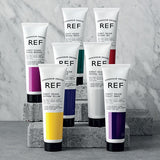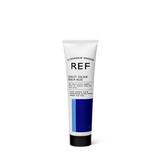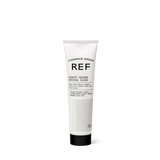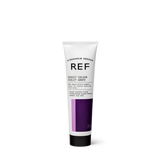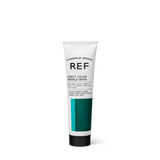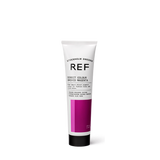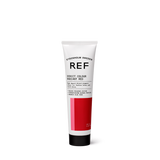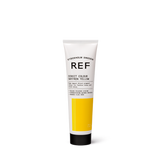Colors include Saffron Yellow, Radiant Red, Orchid Magenta, Violet Grape, Denim Blue, Emerald Green and Crystal Clear.
Direct Colors have organic Aloe Vera, which sooths, heals and provides shine. The Quinoa protein strengthens and nourishes, and the Sunflower Seed Oil provides shine and natural UV protection. No developer / No ammonia
Use REF Direct Colors in creative Intense/Vibrant ways to achieve vibrant and fashionable results to any hair. Add tonal characteristics to natural hair. Take level of depth into consideration, imagine Orchid Magenta on level 4, 6, 8 or 10. Add intense vibrant colour to pre-lightened hair. Add to Color Boost Masques and care conditioners. Use to fill or overlay options for “fashion” re-pigmentation.
KEY INGREDIENTS
REF hair colour limits the amount of chemicals used in the production of its products adding natural ingredients to enhance condition, shine and durability to our colouring system.
Quinoa protein
Quinoa protein is among the widest natural spreads of essential amino acids derived from nature. lt assists in the repair, protection, shine and conditioning of hair. T his helps to preserve hair's natural beauty.
Aloe vera
Long known for its healing and moisturizing properties, aloe vera also brings antibacterial and soothing ingredients to the scalp during the process.
Low ammonia
With less than 2% average ammonia content, REF ensures proper lift and deposit ratios at any level of colour choice.
Anti aging
Contains "Thermus thermophilus", an effective, heat activated antioxidant that protects the hair and scalp from both UV-A and UV-B rays.
FEATURES & BENEFITS
- Aloe vera -long known for its healing and moisturizing properties, aloe vera brings antibacterial and soothing ingredients to the scalp during the colour process, relieves itching and provides illuminating shine.
- Low ammonia -with less than 2% average ammonia content, REF ensures proper lift and deposit ratios at any level of colour choice. With a dilution of 30%, this creates a more gentle grade of ammonia.
3.Anti aging -our REF colour contains "thermos thermophilus" an effective, heat activated antioxidant that protects the hair and scalp from both UV-A and UV-B rays. Promotes ceramide production which helps prevent aging of the hair and scalp. Helps maintain healthy looking hair.
4.Dye load -60% dye load allows for excellent grey coverage and optimizes reflection in light. High shine. Dye load in REF colour is the ratio of pigment in our colour. Our colour is much more opaque. You can create a more translucent look by adding our Neutral Booster.
5.Vacuum manufacturing. REF hair colour is produced with vacuum manufacturing. T his is a digital process that helps keep the hair colour pure, colour never comes in contact with air or oxidizing agents.
6.Cruelty free and 100% vegan.
7.Batch testing. Every batch of colour is tested to maintain consistency with PH, viscosity and dermatology. We mathematically test for consistency in colour tonality to ensure quality every time.
8.Neutral base. Olive green neutral base is neither cool nor warm.
9.User friendly, easy to understand international numbering system.
10.100% grey coverage. Double pigment. 00 series for hard to cover grey, covers even the most challenging grey. T his includes any colour cream that has a. OO after the first decimal point, such as the .003 bahias colour collection.
11.Outstanding shine.
12.Customizable hair colour options. REF boosters create unlimited customizable hair colour options by either enhancing or diminishing tones.
13.Excellent price performance ratio, REF colour saves money for the salon.
TERMS
REF Colour Cream - REF Permanent Colour Cream
Reflex - Influence or tone within the colour.
Boosters - Colour cream tubes used specifically to cancel out, or enhance tones.
Neutral - Considered to be within the booster category, however it is also a lightening cream, as well as a tool to create a bit more translucency when added to Other REF colour creams.
UNDERSTANDING OUR NUMBERING SYSTEM
The swatches for Permanent Colour Cream were created using cream colour and 20 volume. Processed on their level with 50% white hair.
REF Hair Colour System refers to the international numbering system:
Number before the decimal = Hair colour level/depth
1st number after the decimal = Main reflex
2nd number after the decimal = Secondary reflex

Hair colour levels and definition:
Lower number levels are the deepest colours, higher number levels are the lightest colours.
1.Black
2.Extra Dark Brown
3.Dark Brown
4.Brown
5.Light Brown
6.Dark Blonde
7.Blonde
8.Light Blonde
9.Very Light Blonde
10.Extra Light Blonde
12.High Lift Series. Not a level, however it is a high lift tool.
After decimal influences reflex and definition:
Type of reflex after the initial hair colour level - after a decimal point , the number exemplifies the reflex tone and the percentage of influence that reflex/tone has within the tube of colour.
Example: 7.43:
7=Level of colour/depth
4=Primary reflex of Copper
3=Secondary reflex of Golden
.0 Natural
.OO Intense Natural *Double pigmented
.1 Ash *blue/green
.2 Pearl *blue/violet
.3 Golden
.4 Copper
.5 Red Brown
.6 Red
.7 Violet
.9 Green
REF COLOUR WHEELS
The two colour wheels represent the basic colourimetry. The placement of the colours helps you define the primary, secondary and tertiary colours and to identify complementary colours. For example, the colour purple and yellow are on the opposite sides of the wheel, which shows that they are each other's complementary colours. Blended in equal parts, they neutralize the reflection.
The wheel shows the nuances that have a higher quantity of basic brown pigment*, for a total grey coverage. The .OO and .003 are double pigmented colours, which gives a darker result and is placed accordingly.
The wheel shows the nuances that have a higher amount of reflections and give a vibrant, intense colour result.
* When mixing three primary colours you obtain brown. The natural colours have a variable intensity of brown according to the level. This is to ensure a perfect grey coverage.


Eumelanin
Eumelanin is large in structure and Will completely dissolve during the bleaching process. lt is found as the predominant pigment in people of nordic and asian origin. Its blue/violet colour is a direct compliment to the orange/yellow pigment in pheomelanin. T his explains the wide variety of naturally occurring hair colour all over the world. Eumelanin is easy to lift during blonding processes and is the first pigment to release when Iightening.
Pheomelanin
Pheomelanin is small in structure and never fully released from hair. Very heavily present in Africa and people of hispanic origin, cannot be lifted past underlying pigment of level 7. In caucasian people it may be lifted to an underlying pigment of level 9 but Will Ieave yellow residue. Pheomelanin is always found in any colour that is level 7 or darker but the concentration Will depend on ethnic origin. If unsure ask client and also check eye colour for gold flecks, a sign that pheomelanin is present in high concentration. High lift blonding with a colour application should only be a highlighting technique in this scenario. Only all over bleaching Will reach the desired level of lift to achieve a desired result. In levels 3-6 our High lifts Will give beautiful caramel results due to neutralizing affects.
Client consultation
For optimal results, a client consultation is necessary. A technical diagnosis of the hair's condition is fundamental for the success of any colour treatment. A good diagnosis Will provide the information required for a positive colour experience.
Determine natural level
- A) Use the REF Colour Swatch Book to determine the correct natural level.
- B) Determine the % of grey hair needing to be covered. Refer to to avenues of gray coverage portion when formulating.
- C) Be sure to understand the history of client's hair.
- D) Analyze the hair condition, integrity, porosity and existing level of the hair.
- E) Educating your client with the ability or inability to achieve their desired result is recommended. On occasion, a client may be asking for a colour or technique that is simply unobtainable at the time for the client. If that is the case, REF recommends you walk your client through understanding why this cannot be achieved. If there are steps to an ultimate goal, you may wish to help your client and their understanding of these steps especially if it is multiple visits.
- F) Always verify the maintenance level that Will be necessary in order to continue the desired colour. Client must understand the need for retouches, level of maintenance, and the commitment to their desired colour for optimum results.
- G) Sensitivity Test: REF recommends a preliminary sensitivity test. In order to do a sensitivity test, mix a small portion of the REF colour cream, place it on the inner elbow of the client in order to see if there are any reactions. Never assume a client Will not react without suggesting a sensitivity test.
- H) Check gold flecks in eye colour, as well as the black ring around eye colour as this helps to assess ability to life. It also tells you if the client Will pull strong gold tones, etc. Please refer to the Eumelain and Pheomelanin portion of this manual.
Technical diagnosis important steps
Technical diagnosis of the hair's condition is fundamental for the success of any colour treatment. A good diagnosis Will provide all the information required for a positive colour experience.
- Hair type:
Coarse (target level or choose h level darker) Medium (use your target or desired target shade) Fine (choose one level Iighter)
- Natural hair colour level and reflex/tone:
You Will also need to know the level and reflex/tone of any existing colour. Use your REF colour swatch book/chart in order to reference as your guide,
- Percentage of grey hair:
Choose the most suitable oxidizing cream developer and REF colour to obtain an even final result. Identify the most suitable processing time. Consider room temperature as well.
- Leve' and tone of your desired colour/target shade:
Using the shade selection guide and the REF Colour Chart as your reference/guide to accurately determine the level and tone.
- Eyes:
Look for gold flecks in the eyes for appropriate knowledge of lift. Check for the thickness of the black ring around eye colour to understand the ease or ability to obtain lift with the client's hair. Please refer to the Eumelanin and Pheomelanin portion of this manual for additional information.
TECHNICAL DATA
Technical data needed to access accurate colour and follow up maintenance- suggestion for client card.
To maintain accurate and consistent colour, REF recommends that you always keep records of all of your colour services, as well as maintenance regimen of REF hair care and styling products.
Here are suggested considerations for ALL colour services:
- Client name
- Date of service
- Stylist name
- Client's phone number
- Hair type (coarse, medium, fine)
- Hair condition (normal, dry, processed)
- Previous treatments/history
- Natural hair colour at roots/new growth as well as midshaft to ends.
- Percentage of grey
- Areas of stronger grey
- Desired result
- Use of any prescriptions or hormones, etc that may affect hair
- Sensitivities to any Other products including skin care, creams, etc
- Use of caffeine (this may cause some scalp sensitivity if excessive use)
- Eye colour- strong yellow/gold flecks in eye colour? T hin or large black ring around iris. Refer to the Eumelanin and Pheomelanin portion of manual for definition.
Service information:
- Repigmentation needed. If so, formula.
- Colour choice for roots/new growth.
- Colour choice for the midshaft-ends.
- Developer Used
- Formula ratio and measurements including developer.
- Processing time.
- Result observations:
REF PERMANENT COLOUR CREAM PREPARATIONS
REF Permanent Hair colour systems are designed to accomplish 4 major principles of colour results:
- Grey coverage
- Lightening
- Darkening
- Tonality change
REF HAIR COLOURING CREARN DEVELOPER
1- Covers up to 100% Grey * 20 Vol.
2- Lightening up to 4 levels with proper formulation.
3- Dedicated developers to ensure maximum desired results.
4- Processing times:
30 Minutes for average processing
40 Minutes for resistant hair
50 Minutes for highlift blondes
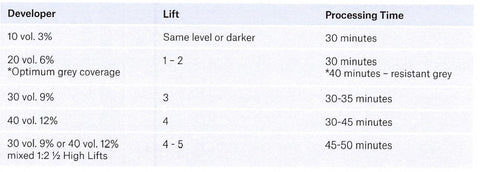
NOTE: REF does not recommend use of heat for processing colour.
REF Colour cream mixing ratio:
The mixing ratio for average retouch is I part
colour cream to 1.5 parts developer. Example: 20g of REF colour + 30g developer.
REF Colour Cream high Iift mixing ratio:
For special high lift colours the mixing ratio is 1 part colour cream to 2.5 parts developer. Example: 20g high lift colour cream + 50g developer.
REF coverage mixing ratio:
For difficult and hard to colour grey - see grey hair section in this manual.
The mixture may change colour after a few minutes in colour bowl.
The apparent colour of the colour cream does not affect the final colour result.
Mixing ratio examples:
50g colour cream = 75g REF developer
20g colour cream = 30g REF developer
10g colour cream = 15g REF developer
Preparation and application of REF colour cream
REF Permanent Hair Colour Creams are a soft, fluid cream easily dispensed from the tube.
Upon mixing with the developer, the consistency becomes a gel cream, releasing a conditioning colour for hair.
Mixing of REF colour cream should be in a plastic bowl, mixing thoroughly to obtain a smooth cream. If you use a whisk, be sure to use a plastic or nylon whisk. lt is not recommended to use any metal objects in the mixing process.
Use of electric scales is recommended to guarantee correct and easy-to-repeat exact formulation and mixing ratios ensuring consistent results.
REF cream developer:
REF colours are designed to work with REF developers available in IO, 20, 30 and 40 volume. Choice of developer Will depend on amount of lift or deposit required for chosen process:
6 volume/I.9% - Toning with a choice of our permanent colour. Just toning, no lift, light deposit.
10 volume/3% - Level on level colour, darker colouring or toning. 10 volume delivers 100% deposit and up to 1 level of lift.
20 volume/6% - Grey coverage and up to 2 levels of lightening, 20 volume delivers 80% - 100% deposit and up to 2 levels of lift.
30 volume/9% - High lift blonding or lifting action. 30 volume delivers 60%-80% deposit and up to 3 levels of lift.
40 volume/12% - Ultra high lift blonding, maximum lifting action. 40 volume delivers 40%-60% deposit and up to 4 levels of lift.
If desired, you may mix equal ratios to achieve between volumes, such as: 30mI of 20 volume + 30 ml of volume = 25 volume.
If desired, you may mix 2 parts higher volume and I part Iower volume to create a medium volume, such as: 30 ml of 30 volume + 15 ml of 10 volume = 20 volume.
APPLICATION
Apply to unwashed or towel dried hair under normal circumstances. REF does not recommend cleansing prior to colour service for permanent colour cream application.*
* Please note if client has applied temporary root concealing products, may need to cleanse prior to application.

Virgin hair application for Iightening with colour cream:
Note: Preliminary sensitivity test is always recommended.
The use of weight scales is recommended for accuracy and consistency in formulation.
Apply to dry unwashed hair.
Step 1
Apply the defined colour cream mixture to the lengths and ends. Process 20 minutes.
Step 2
Prepare the desired mixture again and apply to the roots, processing time 20-25 minutes. Total processing time 40-45 minutes.
Re-touch or regrowth for coloured hair:
Step 1
Apply the chosen formula to the re-growth.
Step 2
Distribute remaining product formula on the lengths and ends when refreshing.
Complete the processing time of recommended 30-40 minutes.
This application refreshes the colour throughout the mid lengths and ends leaving hair soft and shiny. Note: REF recommends using one shade lighter of Soft Colour for regular colour refreshing vs. the use of Permanent Colour Cream.
Grey coverage
REF Colours have been formulated for level to level results on 70% grey hair. With REF Colour Cream, you are assured a 100% grey coverage without use of .00 or .003 intense colour cream.
Note: You may choose 30 to 45 minute process for grey coverage depending on % of grey.
THREE AVENUES OF GREY RESISTANT COVERAGE
- Add up to 25% of .00 or .003 for hard to cover grey.
Use up to 25% of the .OO or .003 intense grey coverage permanent with any Other colour to insure grey coverage. Note, the .OO intense series is double pigmented, so it Will come across deeper and slightly darker than the actual colour. Therefore, if target colour is to be a level 7, in the intense series, use 8.00 (one shade lighter than target colour) to avoid a shade darker appearing end result.
- Pre-staining -2 shades lighter (.3 golds) with 6, 7, 8 levels.
Choose a shade of colour 2 levels lighter than desired level, with a .3 colour reflex to pre-pigment. Add the target colour on top of the direct pigment after application. Process normal time. This would most often be done, only when necessary, along hair line in front and temples.
3. Colour shifting. T his is the most popular grey coverage formula to insure penetration into the cuticle. Formula is equal parts with 30 vol. (Or use equal parts with 20 volume, however, must go up one shade lighter for use with 20 volume when using colour shifting technique). (Not necessary to use .OO by itself.
The easiest and quickest way to insure grey coverage: Using equal parts of colour with 10, 20 or 30 volume, 1/1 ratio, the developer Will open the cuticle enough to drive the colour in to the hair. If including some .OO or .003 series into the formula, you may wish to use one shade lighter of the double pigmented series due to it's intense pigment.
Or, you may choose the following formula for percentage of grey:
For a percentage of less than 50% it is recommended to use a lighter shade. For example: To obtain a level 7, use our 8.
From 50% to 70% of grey, apply shade on shade for example: To obtain a 7 use 7.
Over 70% white hair, use a darker shade, for example: To obtain a 7, use a 6.
REF INTENSE NATURALS
REF intense naturals our .OO series (This includes the .003 series).
REF colour cream intense series ( .00 or .003) contains double pigments and are designed to provide better grey coverage on resistant hair or hair that has over 50% white.
When using our intense naturals our .00 series, keep in mind it is a deeper, warmer and more intense pigment. Therefore, you may wish to add 25% of the intense natural to the formula to cover grey.
REF intense naturals are created to give a deeper, richer tone. Therefore, when using, our Intense formulas, keep in mind, there could be a deeper result. If using 25% or more of our .OO series, you may wish to adjust the formula to compensate for the richer deeper coverage.
Example for intense natural.OO series: If target is level 7. When using a .OO series of 25% or more, you may prefer to use 8.00 since double pigment in our .00 series can appear slightly darker.
REPIGMENTATION / STAINING
When hair is lightened, underlying pigments are removed to create blonde tones. T his technique involves replacing the missing underlying pigments that support the colour at the level to which you wish to colour.
Warm tones must always be used to replenish the underlying missing tone (colours with Golden .3, Copper .4 or Red .6 tones).
When to re-pigment:
REF Recommends use of Soft Colour as the preferred method of re-pigmentation. In those instances where you do not have Soft Colour:
The technique of repigmentation is used when you desire to:
Darken previously coloured or highlighted hair by 2 or more levels.
Re-colour highly stressed hair that has been compromised. (Example: excessively lightened hair with highlights or de-colourized or compromised hair). Note: Hair under these conditions typically only absorbs cool tones due to molecular size of colour. You may wish to offer one of our hair treatments to build integrity back into the hair prior to service).
Replacing missing warm pigments ensures proper tonality of finished colourization.
How to re-pigment:
Previously lightened hair lacks warm pigments. Tones must be restored to ensure the colour is absorbed evenly and therefore preventing it from taking on dull tones or too much ash. Choose REF colour cream with a golden tone such as the .3 Golden, the .4 Copper or .34 Golden Copper. T his colour should always be one that is two levels lighter than the desired with warm undertones.

The repigmentation colour chosen Will be based on the following variables for your client:
- Hair porosity.
- Current level and tone of hair before repigmentation.
- Desired shade - if repigmenting to achieve a neutral or ashy result you Will need to utilize the milder toned shades from the recommendation chart. If repigmenting to achieve a red or copper shade you Will need to utilize the more vibrant toned shades from the recommendation chart.
COLOUR BOOSTERS
REF Colour Boosters are used to achieve two different results:
- To enhance and add intensity with the chosen tone/reflex.
- To cancel or neutralize out an unwanted tone/ reflex.
REF colour boosters are pure colour tones used to add extra tonal intensity to any REF colour or to correct the tone. The lighter the base shade, the less mix of booster is required, the darker the base shade, the more addition of booster is required.
To neutralize out unwanted tones, REF recommends chooing a formula where the booster does not exceed 30% of the colour formulation.
When using Boosters, it is ideal to mix the colours together first with a whisk or REF Colour Brush prior to adding developer for most even pigment distribution in formulation.
Example for enhancing a tone.
When enhancing you may go above and beyond your base colour by adding up to 30% of a Booster to your formula.
Example for enhanced:
Example #1 -Desired result is a 8.46 with enhanced red pigment. Mix gog 8.46. This equals total of 30g total colour cream. Add 10g red booster. Since you are enhancing, you Will want to pay attention only to the measurement of the base colour. You Will therefore add your 1/1.5 ratio of 20 vol to the measurement of the base colour 30g only. Therefore, 45g of 20 vol. The key is that you are adding the enhanced booster colour in addition to the regular measurement of the colour/ developer ratio.
Example #2 -Desired result is a darker deeper based 8.66 with more violet. Mix 30g. 8.66 with 10g violet booster. Colour only is 30g. 10g violet booster. Mix. 1/1.5 formulation equals 45g 20 vol.
Example for correcting or to cancel out unwanted tones:
Example # 1-Desired result is a neutral 6 ash with some grey coverage needed. Mix 30g. 7.003 and add 6g blue booster. Total colour with booster is 36g. Add 1/1.5 ratio of developer add 54g. 20 vol. When cancelling, you add your booster colour prior to adding the developer. In this formulation, we wish to cancel out any unwanted gold from the 7.003, therefore, we add only 6g of the blue. (Note: Blue booster adds some depth to the formulation. Be aware that when using .00, you also may have extra depth due to the double pigment, so therefore in this example, we chose to formulate one level lighter than desired level, knowing the .00 as well as the blue may add depth).
Example #2 - Desired result is 9.003 with a but less gold reflection. Mix 30g of the 9.003 with 8g of violet booster. Total colour measurement is 38g. 1/1.5 formulation would require 57g 20 vol. T his Will cancel out the unwanted gold.
Neutral booster:
Neutral is a Iow ammonia based lifting colour cream used to create highly satisfying results.
- Used in 20% amounts of the formula, Neutral Booster Will lighten any colour by one level, leaving the colour clearer. The use of Neutral in the colour formulation will result in a slightly more translucent resuIt.
Example:
40g 7.43 + IOg neutral booster adding 75g developer cream (10 or 20 vol) results is a lighter and more translucent or luminous copper/golden blonde.
- Using neutral booster with 30 or 40 vol. developer cream creates a lightening cream that can be applied to both natural and coloured hair and is useful for obtaining mild lightening or a very natural looking highlights. When using on natural uncoloured hair, expect 2 to 3 levels of lift depending upon application used. If used on coloured hair, expect a 1/2 to 1 level of natural looking slight highlights that offer subtle dimension.
- If you have some banding from previous colour applications, you may try to use the neutral booster to help soften the banding effect and blend the colour more evenly.
REF DECOLOURIZING BLEACHING POWDER
REF decolourizing bleaching powder is high performance, dust free bleach with a blue pigment for anti-yellowing effect suitable for all professional lightening techniques.
* Use of REF Proplex is recommended for hair that has Iower integrity or has been compromised by multiple previous services. Please see Proplex portion of this manual.
Use decolourizer for full head application (see below scalp application) or any highlighting techniques.
Mixing ratio: 1:2 (1 part bleaching powder to 2 parts developer using 20, 30 or 40 vol.
Decolourizer may also be mixed to your favorite consistency for your desired result.
For consistent processing, REF recommends measuring the bleach as well as the developer on scale for future use and note processing time.
Choose the volume of developer according to the level of lift you wish to achieve.
Development time is between 20-50 minutes, depending on the hair colour, level of lift desired, hair condition, integrity, technique, strength of developer and the quantity of the developer used.
Ensure to continuously check the progress of the lifting at regular intervals (suggest 5 min.)
When the target of lift is achieved, rinse off thoroughly with warm water and gently shampoo hair, rinse, use REF conditioner, rinse. Towel dry.
Recommendations:
REF recommends all colour, as well as bleach be mixed in a non-metallic bowl with REF cream developer, using a non-metal whisk for smooth results.
As with any colour, mix in a well ventilated area.
REF bleaching powder can be used for decolourization, mix 1 part powder to 2 parts REF cream developer using 20, 30 or 40 vol.
On scalp application
Do not apply to the scalp if there are any cuts, abrasions, signs of irritation or any concerns with the scalp.
20 volume is the highest developer recommended for use of bleaching powder when used directly on the scalp.
To protect the scalp for full head application, apply the bleach to unwashed hair, this provides protection through the scalp's natural sebum.
For full head application, begin the application where the hair is darkest and apply at the hairline and nape area last.
Application should begin 3 cm off scalp and proceed to midshaft and ends. Once processed, scalp application should be applied checking every 5 minutes. Rinse off thoroughly with warm water and gently shampoo the hair.
PROPLEX
Proplex is used for building hair integrity as well as to heal compromised hair from previous damage due to broken disulfide bonds. Disulfide bonds can be broken during previous services such as thermal or chemical services. Disulfide bonds are under the cortex (exterior) portion of hair.
Defined: disulfide bond.
The covalent bond between sulfur atoms that binds two peptide chains or different parts of one peptide chain and is a structural determinant in many protein molecules. Peptide and disulfide bonds are responsable for maintaining the primary structure of hair. Simply stated, hair has 3 layers. In the inner core is the medulla, the cortex is located outside the medulla in the middle, and the outside is the cuticle layer of the hair. For simplistic sake, in the second layer, the cortex is made of peptide bonds that are linked with Amino Acids. Inside the peptide bond/amino acid area, are hydrogen, salt and disulfide bonds. Disulfide bonds are typically stronger than the salt and hydrogen bonds. They are what is rearranged then healed again when doing services such as a perm, once the neutralizer is put on the hair.
- Mix hair colour and peroxide according to manufac- turer's instructions. Once the hair colour is properly mixed into the bowl add lml of 01 Bonder per every 10g/ml of hair colour cream. Apply the hair colour and leave on hair as per manufacturer's timing. Rinse off and carefully shampoo.
- Apply a generous amount of 02 Perfector from the roots to ends and leave on for minimum 10 minutes. Rinse off and blow dry.
Advise the consumer to use 03 Maintainer twice a week after washing hair. The 03 Maintainer Will buffer with proteins and add nourishment. Apply a generous amount of 03 Maintainer from roots to ends to damp hair. Leave in for minimum IO minutes. Rinse and follow by conditioner.

- Mix hair colour and peroxide according to manufac-turer's instructions. Once the hair colour is properly mixed into the bowl, add 7.5 ml of 01. Bonder per every 50g/ml of hair colour cream. Apply the hair colour and leave on as usual. Rinse off and gently shampoo.
- Apply a generous amount of 02 Perfector from the roots to ends and leave on for minimum 10 minutes. Rinse off and blow dry.
Advise the consumer to use 03 Maintainer twice a week after washing hair. The 03 Maintainer Will buffer with proteins and add nourishment. Apply a generous amount of 03 Maintainer from roots to ends to damp hair. Leave in for minimum 10 minutes. Rinse and follow by conditioner.

- Mix bleach powder and peroxide according to manufacturer's instructions. Once the bleach is properly mixed add 2ml of 01 Bonder per 10g of bleaching powder into the bowl. Apply the mixture and leave on as usual. Rinse off carefully and shampoo. Proplex may increase lifting time. Therefore you may chose to increase your developer volume by one step.
- Apply a generous amount of 02 Perfector from the roots to ends and leave on for minimum 10 minutes. Rinse off and blow dry.
Advise the consumer to use 03 Maintainer twice a week after washing hair. The 03 Maintainer Will buffer with proteins and add nourishment. Apply a generous amount of 03 Maintainer from roots to ends to damp hair. Leave in for minimum 10 minutes. Rinse and follow by conditioner.

- Mix 10ml/g of 01 Bonder with 10ml/g 02 Perfector. Apply on newly washed, towel dry hair from roots to ends.
- Place under heat source for 10 minutes. Rinse carefully.
- Proceed with a second application of 02 Perfector from roots to ends. Spread evenly and leave on for 5 minutes.
Advise the consumer to use 03 Maintainer twice a week after washing hair. The 03 Maintainer Will buffer with proteins and add nourishment. Apply a generous amount of 03 Maintainer from roots to ends to damp hair. Leave in for minimum 10 minutes. Rinse and follow by conditioner.
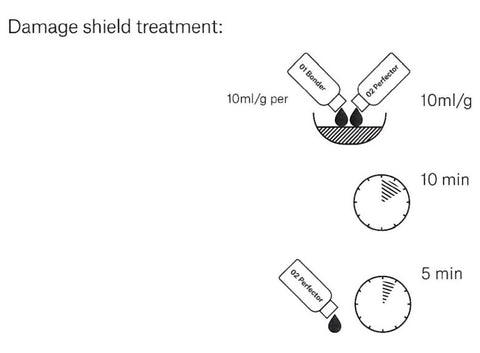
ADDITIONAL PROPLEX INFORMATION
Please refer to REF Proplex Hair Strengthener booklet for basic service directions and/or completion of services.
Please instruct designers to be sure to educate their clients, their #3 Maintainer is to be used as per instructions. More is not better.
Uses: Hair colour treatments, ultra lift hair colour treatment, bleach powder/cream, damage shield treatment. Weight scales are recommended.
Damage shield treatment:
Mix 10ml of #1 Bonder with 10 ml Perfector. Apply on newly washed, towel dry hair from roots to ends. Place under heat source for 10 minutes. Rinse
Mixing ratio for hair colour treatment additional information:
Measure and mix hair colour and peroxide as per manufacturer's instructions. Add lml of 01 Bonder per every IO ml/gr of the hair colour cream. You may add additional Bonder, up to 1 ml per each total weight of both colour cream and developer.
Ultra lift hair colour treatment:
Measure hair colour and peroxide according to manufacturer's instructions. Once hair colour is properly mixed, add 7.5 ml of 01 Bonder per every 50ml/gr of hair colour cream only. You may add additional Bonder, up to 7.5 ml per each total weight of both colour cream and developer. Please note, use of Proplex Will cause the use of 40 volume to act as a slightly Iower volume due to its protective shield, therefore, you may adjust by using less of #1 Bonder, or, by adding slight heat (by lights or otherwise). As always, watch carefully when using heat.
Bleach:
Note: Proplex may increase lifting time. Therefore, you may choose to increase your developer volume by one level. (Any chlorine or minerals in hair should be clarified prior to service.)
Proplex can be used with either Bleach Powder or Cream Bleach. Measure bleach powder/cream and peroxide according to manufacturer's instructions. Once bleach is properly mixed, add 2ml of 01 Bonder per 10 ml/gr of bleaching powder/cream into the bowl. If using less than IO ml/gr, alter formula accordingly. If you wish to decrease lifting time, you may use less Proplex. If you wish to change the consistency of your formula after Proplex is added, you may add more bleach or more developer to achieve desired consistency. T his is particularly important for balayage services.
If using on scalp, due to some sensitivities and body temp. REF recommends use of 20vol on scalp with lightener. Use of higher levels of developer is at stylists' discretion.
If applying multiple or repeated same day applications of lightener, REF recommends use of Proplex damage shield treatment prior to, and in between applications for ideal protection.
Extensions:
Proplex is safe for extensions. Use #2 Perfector sparingly, or be sure to rinse thoroughly after use, as any conditioner may cause slippage.
Deposit only or semi/demi colour:
When using a deposit only or semi/demi colour, you do not change the level of developer you would normally use.
Toning after colour when using Proplex:
If performing a Proplex treatment using #1 Bonder in colour or highlights and you are using a clear glaze or toner after the initial colour treatment, you Will want to use the #2 Perfector after all of the colour service is completed. Therefore, clear glaze or toner would be used, then use #2 Perfector once all colour service is completed.
Thermal straighteners or keratin treatment:
lt is safe to use thermal straighteners on a customer using Proplex. However, you will want to do the damage shield treatment prior to the thermal straightener on compromised hair. Do not add Proplex to the thermal straightener solution.
Permanent wave or body wave treatment:
Note: Do not use #2 Perfector after the Proplex #1 Bonder service when using with a permanent wave or body wave treatment.
Perform permanent wave as per manufacturer's directions as usual. Process as per manufacturer's instructions.
Adding Proplex #1 Bonder to neutralizing portion of perm:
Normal/virgin hair, tinted hair:
Apply neutralizer as per manufacturer's instructions on permanent wave package.
Immediately apply solution of 30ml Bonder mixed with 30ml/g of water in separate container with nozzle. Squirt on top of the neutralizer that is already applied to whole head. Wait 10-15 min. Remove rods and rinse completely clear. permanent wave package.
Immediately apply solution of 30 ml #1 Bonder mixed with 30ml/g of water in separate container with nozzle. Squirt on top of the neutralizer that is already applied to the whole head. Wait 5 minutes, then reapply the #1 Bonder solution a second time and leave on an additional 5 minutes. Remove rods and rinse completely clear.
Damaged hair:
Apply neutralizer as per manufacturer's instructions on permanent wave package. Allow to remain on hair per manufacturer's recommended time. Rinse completely and towel blot to remove excess moisture. Apply #1 Bonder over each towel blotted rod. Wait 5 minutes, then reapply #1 Bonder a second time. Wait an additional 5 minutes. Remove rods and rinse hair until completely clear.
You may find there are Other ways in which to use Proplex- as well as Other formulations for use with this product. You Will decide what works best for you as you gain experience with the product.
SOFT COLOUR MANUAL TECHNICAL MANUAL
The next generation of hair colour.
Features and Benefits:
+ 100% vegan & cruelty free
+ Ammonia free
+ Strengthening quinoa protein
+ Organic aloe vera
+ Demi to permanent capabilities
+ Liquid oil based colour for ease of mixing
+ Clear colour gloss
+ Soft Colour matches REF Permanent Colour tonalities.

Soft Colour chemistry:
MEA (monoethanolamine) based colour for less irritation and more conditioning properties.
Blue/Green based natural series for better neutralizing effect when toning.
Clear can be used to raise the deposit level of any shade it is added to. Clear may also be used as a clear conditioning gloss.
6 Volume Will result in a demi colour effect with gradual release for softer line of demarcation.
10 Volume Will result in a more permanent effect, slower release of colour, and slightly lighter colour result. Lightly shake or tilt bottle of Soft Colour before mixing.
Mixing instructions:
1 part Soft Colour: 1 part developer of choice. Suggested mixing ratio: 30ml/g colour with 30ml/g of developer.
We strongly suggest the use of scales with all colour formulations to ensure proper amounts of each component and desired result.
Amount of colour needed per application Will vary depending on thickness, length and amount of hair coloured.
All Soft Colours may be mixed creatively to produce an endless variety of colour choice.
Clear
1 part Soft Colour: 1 part clear: 2 parts developer
Will result in a lighter, one level shift of deposit.
For example: 15ml/g 7.43 + 15ml/g clear + 30 ml/g developer Will give visual result of 8.43.
You may adjust mixing ratio of colour to clear as necessary for your desired result.
Clear may be used with equal parts 1.9%/6 vol to create a beautiful gloss effect on natural or colour treated hair.
Mixing clear in a 6:1 ratio with fashion colours (any colour that contains a colour influence after the decimal) lighter than level 6, produces a beautiful demi toner that Will tone highlighted hair and not break hair natural in colour.
Salon tip:When mixing Soft Colours, using clear as 25% of your formulation Will ensure great shine and a colour slightly lighter than your base tone. This is preferable for a more natural finish.
TIMING FOR REGULAR APPLICATION:
Soft Colour is designed to be processed at room temperature for 20-30 minutes. Colour Will stop depositing after 30 minutes. Less processing time Will result in lighter deposit of colour with quicker release of tone.
When using Soft Colour as a first time colour service over hair natural in colour, it should process for a full 30 minutes.
Soft Colour used to refresh the mid lengths and ends of a previously permanent colour service, should process for 20 minutes maximum or less for your desired result. Soft Colour as toner. Using Soft Colour mixed with at least 3 parts clear can give a beautiful tone, or a great neutralizing effect, after high-lighting. The timing for this procedure is 2 to 20 minutes depending on the amount of colour deposit required.
Soft Colours recommended uses
Soft Colour is the perfect choice to refresh your beautiful REF colours. When refreshing a previous colour service, always choose or formulate colour 1 to 2 levels lighter than your chosen scalp colour. Hair that has been previously coloured or hair that is natural in colour is considered tone on tone colourization and Will result in a darker effect.
First time colour service: Soft Colour is a great way to introduce your guests to the beautiful colour services available to them. T his is not a permanent decision. Soft Colour, when mixed with 6 vol developer, Will gradually release from hair and exit with beautiful tonality. T his service introduces the colour process and gives the guest an opportunity to 'test drive' colours before they choose to make a more permanent choice.
Grey blending: Soft Colour gives you the tools to blend grey away as much or as little as your guest desires. With a natural release using 6Vol, the line of demarcation is lighter and softer.
If you choose to use 10 vol developer, you Will get a more permanent result and a stronger line of demarcation.
Application techniques:
Soft Colour should be applied to clean, towel dried hair, for the softest colour effect. When applied to dry hair, a darker deposit effect Will be accomplished as well as a soft line of demarcation.
Soft Colour may be applied in any technique that you choose:
+ Full head application
+ Refresh of mid-shaft and lengths
+ Foiling
+ Tone on tone
+ Toner
+ Shine service
+ Re-pigmentation (see re-pigmentation chart in manual)
+ Conditioning service
SOFT COLOUR REPIGMENTING/ STAINING COLOUR CORRECTION CHART
Repigmenting overly Iightened hair. How to achieve perfect underlying pigment for every level:

MIXING AND TIMING FOR REPIGMENTING/STAINING
-All formulations are to be mixed with equal parts 1.9%/6 vol developer.
-Apply with bottle or with bowl and brush to corrective areas.
-Process for 20 minutes at room temperature.
-Rinse until clear- do not shampoo.
-Towel dry.
-Apply desired level Permanent REF hair colour cream with 3%/ 10 vol developer or 1.9%/6 vol or YOLI may use 3%/ 10 vol with Soft Colour as your target colour. (Note: You can choose either REF Permanent Colour Cream or Soft Colour based on colourists determination of hair integrity).
-Process for 20-30 minutes.
-Shampoo and condition with REF Illuminate Colour Shampoo and follow with REF Illuminate Colour Conditioner.
Please note:
REF recommends rinsing and conditioning when using 6 vol. When using 10 vol, REF recommends rinsmg, shampooing, then rinsing and conditioning.
-Highlighting or Iow lighting is possible at this time if desired.











